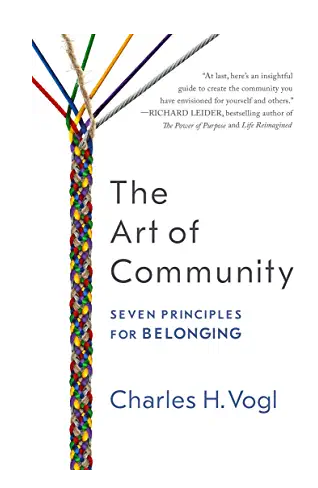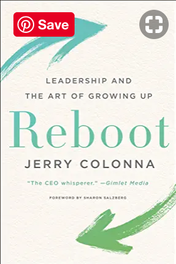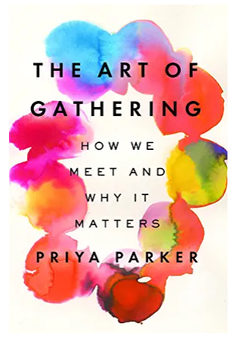Mission: Impact podcast & blog
Build a better world without becoming a martyr to your nonprofit cause
Listen on:
 Here are three books to consider adding to your list: The Art of Community: Seven Principals for Belonging by Charles H. Vogl I was intrigued by the book’s subtitle since I am someone who moved a number of times over the course of my growing up. I spent a lot of time chasing that illusive sense of belonging. With the traditional forms of community breaking down and loneliness on the rise, more people are in the business of trying to create community. It could be an online community, a community of practice or a co-working space. Vogl describes the essential elements to build community including creating a boundary, initiations, rituals, symbols. While a bit philosophical, I found the book very accessible, enriched by stories illuminating the principals.  Reboot: Leadership and the Art of Growing Up by Jerry Colonna I heard about this book from an interview that I heard on one of my favorite podcasts, On Being with Krista Tippet. Jerry Colonna is Tippet’s executive coach. His insights on what people bring to their work and leadership from what they learned in childhood and their family of origin were fascinating. Colanna considers growing up part of being an authentic leader, especially identifying and letting go of those “ghosts in the machine” that we learned growing up, drive our behavior but no longer serve us as adults. Learning to sit in discomfort, letting go of our illusion of control, and peeling back the façade of “everything is awesome!” I appreciate his insights into the human condition. Yet I was struck by how like too many other business books the stories he included were from people represented a rarified stratosphere of our society of venture capital and start up CEOs.  The Art of Gathering: How we meet and why it matters by Priya Parker This book was cited in the Art of Community and since a lot of what I do involves group meetings and gatherings, it caught my interest. What I didn't know is that Parker is a facilitator so the book had particular relevance to my work. Yet the book ranges beyond work focused gatherings and includes what makes a good party or ‘happening’ tick. Like I have advised and then forgotten to follow my own advice, a good gathering/meeting needs a clearly defined purpose. She encourages you ‘not to be a chill host’ and to take leadership of your event, why it is so important to pay attention to meaningful beginnings and endings and how to move the conversation beyond the merely polite to healthy controversy. Whether you would like to make your next get together more meaningful or have an big work gathering to facilitate, you will walk away with a deeper understanding of how to make that happen. Apparently this summer I am studying the “art” of things – since this shows up in each of these titles.
What’s on your reading list? Emerging from Crisis Photo by Pixabay Photo by Pixabay Challenge: A small watershed organization had survived a tumultuous several years after the death of its founder and long-standing executive director. During the founder’s tenure, the board had been a following, governance board. The board led by a new board chair had navigated many challenges including an unsuccessful merger attempt, theft by a caretaker at one of the organization’s properties and other problems. The board decided the organization needed to take stock and reimagine itself, making the most of the legacy left by the founder and rebuilding an organization to meet both today’s realities and live into a new vision its future. Approach: I interviewed the board members and supported board members as they interviewed external stakeholders. Through the interviews, it became clear that the organization while it wanted to engage in longer range strategic planning it was only in the position to do short range planning. Most board members had been involved with the organization for years and many were burned out. Yet some found it challenging to let go and allow new leadership to emerge. Many had come on during the founder’s tenure and were not prepared to engage in the hands on work that the organization now needed from its board and it now had no staff. I facilitated a one-day retreat to help the group uncover what they had learned from their experience and think about where the organization stood in terms of the phases of development that nonprofits typically go through and what it meant for what was required from the board at its present stage of development. Results: Over the course of the organization’s several years of turn around, the board chair had essentially been working part time for the organization without compensation. During the retreat, the board decided to make her executive director and pay her for her work. A new board chair was named. Several board members announced their departure making way for new leadership to engage with the organization. The board also set several short-term goals for the year. Building Shared Leadership Photo by rawpixel.com Photo by rawpixel.com Challenge: A well-respected state level education nonprofit decided to celebrate its 30-year anniversary by engaging in strategic planning to envision its future and set goals for the next 3-5 years. The organization had emerged from a challenging period in its history during which long-standing but no longer financially sustainable programs were sun-setted. The executive director who had been with the organization since its founding hoped to strengthen the organization’s staff and board leadership by increasing shared leadership. The board was small and the majority of it members are relatively new to the organization. The executive director priorities included considering whether the organization’s name adequately represents its work; how to build capacity within the staff and board for greater shared leadership with the executive director as well as longer-term succession planning. Approach: I interviewed all the board members, external stakeholders as well as the staff. I facilitated a session with board, staff and a few external stakeholders that encompassed a look back at the organization's accomplishments over its 30 year history, considered the trends in the wider environment impacting the organization and reviewed the themes that emerged from the interviews. The group then discussed what implications the trends and themes had for the organization as it considered its future direction. Results: Through the interviews a number of issues emerged including the weakness of the board. Through the feedback and discernment process in the first session, the board decided to take a break from strategic planning and focus on its own development. Six months later the board had recruited new members and taken steps to create more a sense of shared leadership with the executive director. Need similar results for your organization? Inquire about scheduling a coaching call. |
Categories
All
Archives
July 2024

Grace Social Sector Consulting, LLC, owns the copyright in and to all content in and transcripts of the Mission: Impact podcast, as well as the Mission: Impact blog with all rights reserved, including right of publicity.
|
Telephone301-857-9335
|
info[at]gracesocialsector.com
|
Grace Social Sector Consulting, LLC, owns the copyright in and to all content in, including transcripts and audio of the Mission: Impact podcast and all content on this website, with all rights reserved, including right of publicity.
|